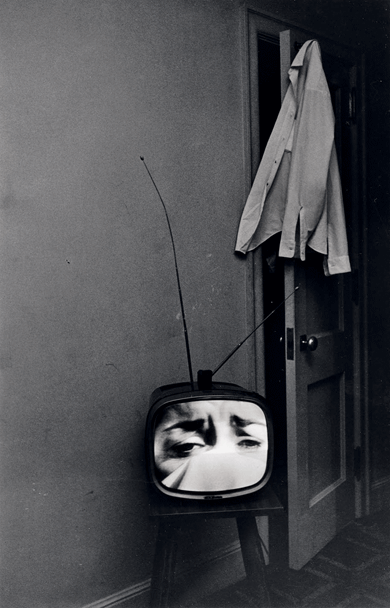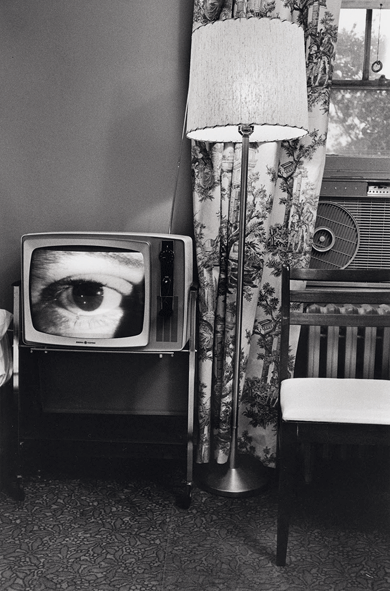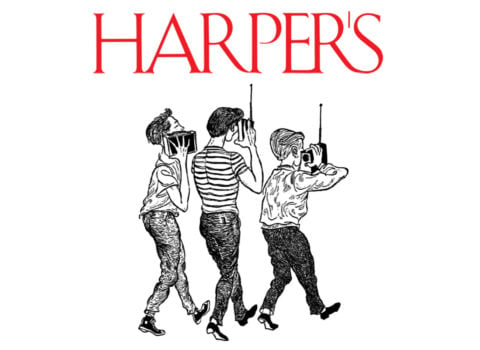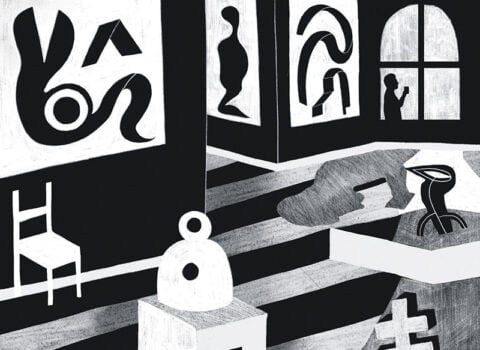Discussed in this essay:
The Platinum Age of Television: From “I Love Lucy” to “The Walking Dead,” How TV Became Terrific, by David Bianculli. Doubleday. 592 pages. $32.50.
Television: A Biography, by David Thomson. Thames & Hudson. 304 pages. $34.95.
Play All: A Bingewatcher’s Notebook, by Clive James. Yale University Press. 216 pages. $25.
In 1970, CBS appointed a new vice president for programming. Within a year, in a move that would soon become known as the “rural purge,” he had canceled Hee Haw, Lassie, Green Acres, Petticoat Junction, The Beverly Hillbillies, and Mayberry R.F.D., some of them among the network’s highest-rated shows. In their stead he introduced The Mary Tyler Moore Show, All in the Family, and M*A*S*H, three of the most esteemed programs in the history of television. By the middle of the decade, he had also added Maude, Rhoda, The Jeffersons, and Good Times, shows that likewise helped to bring a new sense of social relevance to the small screen.
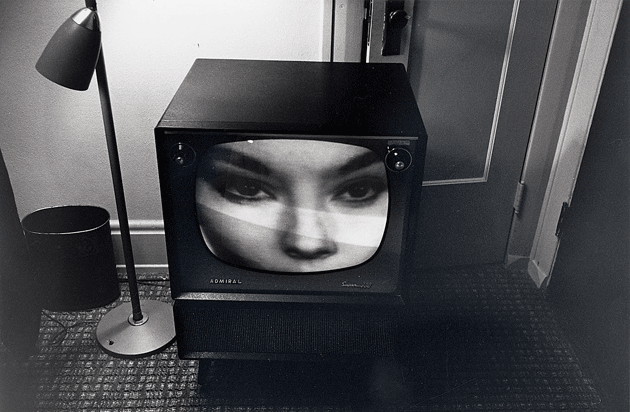
“Florida, 1963,” by Lee Friedlander, whose work is now on view at Fraenkel Gallery, in San Francisco. All artwork © The artist. Courtesy Fraenkel Gallery, San Francisco
In 1975, ABC, the perennial runt of the network litter, appointed a new president of its entertainment division. Within a couple of years, he had green-lit Charlie’s Angels, Three’s Company, The Love Boat, Fantasy Island, and Battle of the Network Stars (satirized by Saturday Night Live as “Network Battle of the T’s and A’s”). Collectively, these shows and others like them earned the nickname “jiggle television,” a new low for the lowest common denominator. They also catapulted ABC to the top of the ratings, displacing CBS after more than two decades of continuous dominance.
The first executive was Fred Silverman. The second executive was also Fred Silverman. And his motive was the same in each case. The revolution at CBS was undertaken not, as the story often goes, out of a high-minded sense of social responsibility or any commitment to artistic excellence. Silverman cut the rural shows and introduced the hipper ones because he wanted the network to pivot from the aging segments of the audience to the more desirable young-adult demographic. When he got to ABC, where he also revived the fortunes of Happy Days, spun off Laverne & Shirley, and oversaw the creation of Roots, the executive whom Time would dub “the man with the golden gut,” continuing to surf the zeitgeist, sensed the opportunities for market share that lay in new directions.
Television, like movies and popular music, is often portrayed as an ongoing battle between the artists and the suits. The artists want creative freedom; the suits want profits. Both propositions are true, but the latter doesn’t mean the suits are evil. It simply means they’re businesspeople: it means they’re doing their jobs. And that is what we — and more important, the artists — should want them to do, if only because it enables them to give the artists something else that artists want (and need, and deserve): a paycheck. When television is at its best, as it’s so often been in recent years, it’s not because the suits capitulate. It’s because they’re smart enough, or confident enough, or desperate enough, to bet that creative freedom can itself conduce to profit.
Which means that the protagonist of this ongoing drama is neither the artists nor the suits. It is the people who enable creative freedom to be profitable and garbage to be profitable, too, who made a hit of M*A*S*H as well as of Charlie’s Angels, the people to whom the artists and the suits are both appealing. The protagonist, of course, is us. If television is so much better than it used to be, that’s because we’re better. What’s more, we were always better. It’s just that television had to change before it was possible for anyone to see that.
How we got from there to here — as the subtitle puts it, from I Love Lucy to The Walking Dead — is the subject of David Bianculli’s encyclopedic new volume, The Platinum Age of Television. Bianculli, who has been a TV critic for more than forty years, attempts to throw his arms around it all, the whole of scripted television. His table of contents runs to half a dozen pages: eighteen genres, including four types of sitcom alone, with five key series focused on for each (and many others mentioned along the way), plus interview-based profiles of twenty-five creators or creative teams, everyone from Mel Brooks to Amy Schumer.
It’s a lot, and as someone who has always enjoyed Bianculli’s work on NPR’s Fresh Air, where he’s served as television critic since 1987, I expected the book to deliver a lot. So it gives me no pleasure to have to report that The Platinum Age is not only quite a bit less than the sum of its parts, its parts aren’t all that great to start with.
Bianculli does provide some interesting material. “If one TV series inspired more of the people interviewed in this book than any other,” he tells us, “it was The Twilight Zone.” Cable networks became possible in the 1970s, he notes, after the development of geosynchronous broadcast satellites. In a rare extended discussion, he explains how I Love Lucy pioneered the still-standard three-camera format for sitcoms (which involved enlisting the German cinematographer Karl Freund, whose credits included Metropolis), incidentally making possible, by improving the quality of the resulting recording, that pillar of the network business model, and of everybody’s childhood: the rerun.
But, by and large, Bianculli’s book is an unenlightening slog, a Bataan Death March through a jungle of minutiae — heavy on factual detail, very light on context and analysis. With ninety series to cover, plus extensive connective tissue within each category, stock publicity shots that don’t do much but take up space, and all those individual profiles, Bianculli seldom gives us more than a couple of pages on any single show. Even then, it’s mainly who, what, and when, not how or why — the creators and their backgrounds, the basic premise and the leading actors, a memorable episode or two, Emmys won and ratings earned, and, at best, the briefest stab at an idea.
The section on South Park, for example, spends a lot of time explaining how the program got on the air, but as for analyzing what it’s done there, we get little more than this: “The show skewers pop culture and current events in all directions.” Bianculli name-checks a couple of minor characters, mentions the tough production schedule, and free associates, by way of an episode on Scientology, to The Book of Mormon. He tells us that the series has acknowledged its debt to The Simpsons, but he doesn’t tell us what that debt consists of. He also doesn’t tell us anything about the program’s visual aesthetic, or the ways its humor works (it isn’t just fart jokes), or its tumultuous reception when it first appeared, or the ways that it’s developed in the twenty seasons since.
The Platinum Age is less a study, a connected series of insights bound together by a sustained argument, than it is a catalogue. The problem isn’t helped by Bianculli’s governing conceit — both what it is and how he handles it. The idea is Darwinian: for each of his eighteen species, he undertakes to trace the evolution that has brought us to the present moment. In every case, he tells us, “both the programs and the characters become significantly more complicated” (just as biological species evolve, the implication is, in the direction of increasing complexity). The plan sounds promising, at least at first, but Bianculli doesn’t try to execute it more than intermittently. He would have needed to tell us a great deal more about each of his “individuals,” his programs — a great deal more of genuine substance — before he could have linked them in ways that went beyond the mere chronology of this-and-this-and-this. If he could have linked them: The Bob Newhart Show happened, and then, eleven years later, Seinfeld happened, and then, twelve years after that, Louie happened, but is there any reason to believe that one grew out of the other, or that they are even the same kind of program? So busy is Bianculli counting leaves and sketching acorns that he scarcely notices the trees, let alone the whole forest.
Is evolution, especially as Bianculli conceives it, really the best way to describe what’s been going on with television? For one thing, complexity is not the same as quality, and quality is what we really care about. Modern Family is unquestionably more complex than All in the Family, but would anyone say it’s better? More important, television genres are not really species, in the sense of being self-contained. Bianculli’s evolutionary links are so often weak or tenuous or absent because developments in television freely cross from one type of show to another. Aaron Sorkin creates dramas, but “the show, I think, that has informed everything that I’ve ever written,” he says, is M*A*S*H.
There is a broader issue, too. The evolution Bianculli traces in the “single working women” sitcom — from Mary Tyler Moore to Murphy Brown to Girls — is an increase not so much in complexity as in feminism: the ways that women’s lives were changing, and the extent to which those changes could be represented on the screen. But feminism didn’t happen only on the working-woman sitcoms. Mary Richards and Murphy Brown and Hannah Horvath are part of a larger change that has included female characters on shows such as L.A. Law, Roseanne, The West Wing, The Good Wife, and many others. More to the point, feminism didn’t happen only on TV. The biggest flaw in Bianculli’s evolutionary framework is that evolution doesn’t take place in a vacuum. Species change because their environments change, and the environment in which television programs struggle to survive is the culture — which is another name for us. Bianculli’s genres have evolved in the direction of greater complexity — and for the most part greater quality — not each out of some sort of inner necessity, but because the medium as a whole has evolved in that direction. And TV has changed, for the most part because the audience has changed — although the process, at least until recently, was far from linear.
We call the early days of television the Golden Age, though I wonder if it wasn’t really just a Stone Age gilded by the glow of our nostalgia. In any case, much of what was good about it — much about it, period — was drawn from existing media. Variety shows, as Bianculli tells us, came from vaudeville. Westerns, which ruled the ratings in the late 1950s, came from Hollywood. Anthology series like Playhouse 90 and Kraft Television Theatre, which consisted of self-contained, single-episode dramas, often of very high quality, came from the stage. And the sitcom, plus a great deal more, came from radio.
Once television was standing on its own two feet, it proceeded to fall on its face. As early as 1961, Newton Minow, the chairman of the FCC, was famously inveighing against the “vast wasteland.” TV in the 1960s was abysmal: “hillbillies, cowboys, and spies,” as one critic put it, not to mention, as Bianculli reminds us, martians, genies, and talking horses. Like Hollywood, which also did a lot of sucking in the Sixties, scripted television tried to act as if the counterculture — which increasingly meant the culture — did not exist. There were exceptions, such as Bianculli’s beloved Smothers Brothers Comedy Hour (he has written a book about the show, which was canceled in 1969 after two tumultuous seasons), but the Sixties did not really show up on television until the Seventies, with Silverman’s coup de main at CBS. By 1974–75, the top ten shows included three programs that centered on black characters — The Jeffersons, Good Times, and Sanford and Son — plus Chico and the Man, Maude, Rhoda, All in the Family, and M*A*S*H.
But like the New Hollywood, a movement that had emerged a few years before Silverman’s revolution, the heyday didn’t much outlast the middle of the 1970s. At the movies, all was crushed beneath the juggernaut of Star Wars and its progeny, escapist blockbusters that traded in juvenile fantasies and crypto-nationalist myths. In the living room, it was jiggle television, the retrogressive nostalgia of Happy Days and Laverne & Shirley and the reactionary chic of Dallas. A vast cultural retrenchment was under way, soon to find its political expression in the ascendancy of Ronald Reagan.
In retrospect, the 1980s and 1990s can be regarded as a slow, halting climb from out of those depths toward the high plateau we stand on today. Hill Street Blues arrived in 1981; Seinfeld, a comparable breakthrough in comedy, in 1989. At the time, however, the great shows felt like exceptions, and some of them disappeared quickly. Twin Peaks came and went in a year (1990–91), as did My So-Called Life (1994–95). Bianculli has sections on St. Elsewhere (1982–88) and the great Larry Sanders Show (1992–98), the first important scripted cable program, as well as on The Simpsons (1989–forever), NYPD Blue (1993–2005), and a few others from the period. But as late as the start of 1999, it remained possible to feel that if you weren’t watching television at all, you weren’t missing very much — that TV was still basically garbage, if now more slickly packaged garbage, and that it was never going to get much better.
And that, quite suddenly, is when everything changed. Bianculli pegs the last year of the century as the start of his Platinum Age, and he will get no argument from me. It was the year that HBO began to televise The Sopranos. (It also saw the debut of The West Wing and of Jon Stewart’s version of The Daily Show.) By 2002, The Sopranos had been joined on HBO by Six Feet Under and The Wire — none of them like anything that anyone had ever seen before, and all of them better than anyone could ever have imagined. A new complexity, yes, but also a new depth, daring, wit, moral seriousness, psychological and social realism, sense of tragedy — a new artistic brilliance. The floodgates had opened, Showtime, FX, AMC, and other networks jumped in, and everything seemed possible, because everything was.
How did we get there? The first answer is obvious: the advent of cable. Broadcast networks, it’s been said, sell viewers to advertisers, while HBO sells programs to viewers. It took chances the established networks wouldn’t or couldn’t. But while that tells us how the first great programs got to viewers, it doesn’t tell us how they were created, or why the audience embraced them.
The answer to the first is everywhere in Bianculli’s book, especially in those profiles. James L. Brooks (Mary Tyler Moore), Larry Gelbart (M*A*S*H), and Norman Lear (everything else) had either grown up watching television or started as writers in the new medium. Today’s creators grew up watching them. Television got good, or good again, as soon as there were enough people making shows who had come of age with it; it got great as soon as there were enough who had grown up steeping in the work of that earlier generation.
But the creators haven’t been the only ones who have been watching. We’ve been watching, too; we’ve been training up. Every aesthetic advance — Hill Street’s overlapping dialogue, Seinfeld’s quick-cut scenes, the tendency of characters on Platinum Age programs, as Bianculli notes, to leave the most important things unsaid — has prepared us for the next. A great audience, Fran Lebowitz has said, is just as important for the creation of great art as great artists are. Great audiences create great artists, by giving people the freedom to take chances. “The thing I knew going into Louie,” Louis CK tells Bianculli, “was that the American palate, the ear, was tuned better, and that people were willing to go anywhere you wanted them to.”
We’re also simply better educated now. In 1950, the share of young American adults who had graduated from college was 8 percent. By 2000, it was 29 percent. (As of last year, it was 36 percent.) In 1950, scarcely half of all adults had even finished high school, as compared with about 90 percent since 2000. Our cognitive training, on average, is incomparably more demanding, and more and more of us are using that training at work. The class of people who used to be known as “knowledge workers” and are now referred to as the “creative class” — not just artists and designers but scientists and engineers, teachers and professors, high-tech workers, legal and medical professionals, and more — roughly doubled as a share of the workforce from 1950 to 1999 (to 30 percent), and roughly quadrupled in absolute numbers. This is not to say that high-school dropouts can’t appreciate Transparent or that every doctor watches Breaking Bad, but it does mean that television is addressing itself to a radically different population than it was in 1950, or even 1970.
Yet it may not be quite as different as it seems, because we were probably never as bad as TV made us look. The best thing that cable has done for the quality of scripted television is also the thing that everyone laments about the media landscape today: it has chopped up the audience into smaller and smaller pieces. Of course television was a wasteland in the days when there were no more than three networks; executives could only program shows that they thought would appeal to a sizable chunk of the country. Yes, America shared a common frame of reference back when everyone watched Walter Cronkite, but that was also when everyone watched The Beverly Hillbillies, the top-ranked show the year that Cronkite took the anchor’s chair, with a rating of 36. NCIS and The Big Bang Theory, last year’s highest-rated scripted programs, clocked in at 11.6.
Cable has allowed us to see just how diverse — and therefore how sophisticated — the audience really is. There may always have been a few million people who were interested in something like The Wire, which are all that ever watched it when it aired. Now there are creatively daring, commercially viable series that attract even smaller numbers. In three seasons (with at least two more on the way), Broad City has yet to crack a million. There’s still a lot of crap out there, to be sure — more than ever, with all those bottom-feeder networks like Bravo, E!, and VH1. It’s mostly crap, but why shouldn’t it be? It’s mostly crap in every medium: crap fiction, movies, music, magazines. Pop culture has been mostly crap since it began, which means pretty much since Gutenberg. One of the first forms of mass entertainment, the bloated, turgid chivalric romances of the sixteenth century, are what Cervantes invented the novel by writing against. The only difference, when it comes to television, is that the crap is much more visible. Readers of serious fiction are at best dimly aware of sewage merchants like Nora Roberts or Dan Brown, but Kim Kardashian is right there on the same device as everything else we watch. What cable has really done is make TV like every other medium, one whose range reflects the true breadth of American tastes.
All of which means that the old critical commonplaces, whether of the “boob tube” or the “medium is the message” variety, are long since obsolete. Which in turn makes David Thomson’s Television: A Biography so deeply disappointing. Thomson, who has written many books on cinema, is widely regarded as our greatest living film critic. But here, attempting to conquer an adjacent medium, he badly misfires. The book has its pleasures, especially when Thomson focuses his movie-critic eyes on individual moments: Angie Dickinson flirting with Johnny Carson; James Garner and Mariette Hartley flirting their way through nearly 300 Polaroid commercials, an entire movie thirty seconds at a time.
But Television, on the whole, is a rambling farrago of secondhand McLuhanisms and self-important sociocultural bloviation. If Bianculli misses the forest, Thomson’s book is all forest, less a consideration of specific programs than a sermon on the evils of a demon known as Television. Thomson tells us that he has been thinking about the medium his whole life, and that is perhaps part of the problem. His book exists within a conceptual framework that might have been assembled thirty years ago. Nowhere is there any hint that television today is significantly different from television in the 1980s or the 1960s. Thomson manages to get through an entire chapter on the news (or, as he calls it, “the News,” another large abstraction) with just a couple of passing mentions of the cable networks. As for Bianculli’s Platinum Age — that is, everything since 1999 — it is largely ghettoized within a single chapter, and despite the fact that it’s most recognizable character type is the masculine sociopath (Tony Soprano, Don Draper, Walter White, et al.), Thomson manages to say things like “television seldom strays far from likable people.” The medium may still be the message, but the medium has changed.
Far better, though briefer, is Clive James’s Play All: A Bingewatcher’s Notebook. James, as canny a critic as one could desire, and as elegantly smooth a writer, places at the center of his book a figure Bianculli omits and Thomson condescends to: the viewer. Specifically, himself, as he works his way through boxed sets of The Good Wife, Breaking Bad, Game of Thrones, and other Platinum Age standards. I don’t agree with all his judgments. (I still don’t know how he or anybody else can fail to see the ludicrous House of Cards for what it is: prestige television at its worst, an overinflated balloon of high-concept flatulence.) But vigorous dispute — loud and personal and unself-conscious — not pious worship of canonical relics, is the hallmark of a living art, which means an art that ordinary people love enough to fight about.
James, unlike Thomson, actually likes television — likes it more than film, in fact. For Thomson, seriality is the guarantee of triviality: “real acting and catharsis depend on danger and the prospect of closure.” For James, the very length of long-form television gives it a superior ability to “search souls,” its actors greater scope for the virtuosic display of emotional range. Thomson expresses a prudish horror at the thought that anybody in the business might be interested in making money. James understands that good television “serves the producer, but only because it serves the consumer first.” What’s more, he knows that great popular art appeals to the lizard brain as well as to the monkey brain: the former not only with nudity, violence, cursing, and beautiful actors, but most of all with story. Thomson and James are both in their seventies, but while Thomson exudes the sour fatalism of the superannuated, James envisions a bright future stretching out beyond his death. His book concludes with his ten-year-old granddaughter, already fluent in the language of the medium, a member of the generation growing up amid the riches of the Platinum Age.
Thomson thinks the TV era is already giving way to the era of the internet, but this is manifestly false. The two are perfectly compatible, because television will still be television — linguistic inertia being what it is, I suspect that we’ll continue to refer to it as “television” — even when we no longer watch it on televisions. Assuming that the people who create it can continue to come up with ways to make us pay for it (and let us hope they do), I don’t see much “disruption” taking place. A good television show is not the kind of thing that amateurs can make in their garage. It costs a lot, and the thing that costs the most is talent.
Talent doesn’t simply happen, either; it needs to be developed. David Chase grew up, as Bianculli tells us, watching programs like The Twilight Zone and The Untouchables, but he also worked in television, as a writer and producer, for almost thirty years before creating The Sopranos. The television business, in its Florence by the ocean there in southern California, has evolved a modern version of the workshop system, where talent ripens through collaborative work under the tutelage of established creators. That’s why even mediocre or conventional programs are valuable in the larger scheme of things. They give creators experience, and they also give them a paycheck, so that they can stick around to work another day. Chase earned his first writing credit on something called The Bold Ones: The Lawyers.
If anything, the new distribution models, including online streaming, are giving the artists more freedom than ever. Without specific time slots to fill, episodes can find their natural length. So, it seems these days, can series, with creators now at liberty to plot a tightly woven narrative, spanning a specific number of seasons, from the inception of a project, rather than dragging the story out as long as the audience is willing to sit still. The very flux in which the medium now finds itself creates more room to operate. “There’s no system in place anymore,” the comedian and podcaster Marc Maron, who just concluded a series of his own, remarked not long ago. Executives, he added, “can’t pretend to know the answers . . . so they trust in the creatives.”
Are there too many programs these days? Bianculli asks the same question, noting that “the total number of prime-time scripted series on broadcast, cable, and streaming services” came to 409 in 2015, up from 280 in 2010 — itself undoubtedly a huge increase from just a few years earlier. A reduction of the herd, such as always follows overpopulation (to speak in Darwinian terms), would not be a catastrophe. In the meantime, television is the only art form I’m aware of where the “middle class” is thriving. There may be fewer people in the business today who can make a Seinfeldian fortune, but there are many more who are able to earn a decent living doing what they do, without having to starve or fit it in around a day job, and that is much to be preferred.
As for us, how lucky to be living through the efflorescence of a great new art. The wasteland, unexpectedly, has bloomed.

